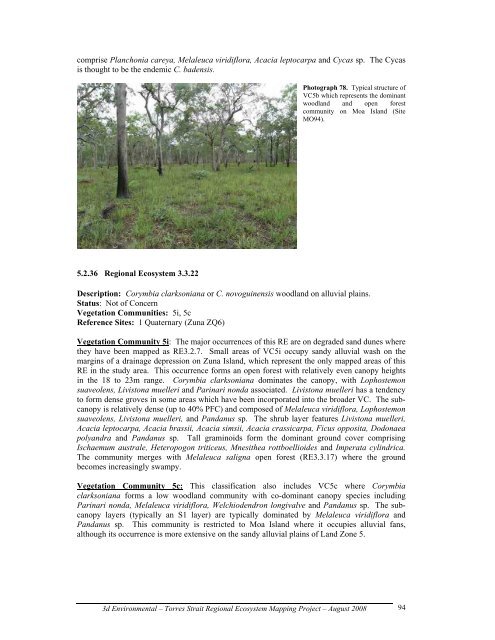Appendix 2 - Vegetation Communities and Regional Ecosystems
Appendix 2 - Vegetation Communities and Regional Ecosystems
Appendix 2 - Vegetation Communities and Regional Ecosystems
Create successful ePaper yourself
Turn your PDF publications into a flip-book with our unique Google optimized e-Paper software.
comprise Planchonia careya, Melaleuca viridiflora, Acacia leptocarpa <strong>and</strong> Cycas sp. The Cycas<br />
is thought to be the endemic C. badensis.<br />
5.2.36 <strong>Regional</strong> Ecosystem 3.3.22<br />
Photograph 78. Typical structure of<br />
VC5b which represents the dominant<br />
woodl<strong>and</strong> <strong>and</strong> open forest<br />
community on Moa Isl<strong>and</strong> (Site<br />
MO94).<br />
Description: Corymbia clarksoniana or C. novoguinensis woodl<strong>and</strong> on alluvial plains.<br />
Status: Not of Concern<br />
<strong>Vegetation</strong> <strong>Communities</strong>: 5i, 5c<br />
Reference Sites: 1 Quaternary (Zuna ZQ6)<br />
<strong>Vegetation</strong> Community 5i: The major occurrences of this RE are on degraded s<strong>and</strong> dunes where<br />
they have been mapped as RE3.2.7. Small areas of VC5i occupy s<strong>and</strong>y alluvial wash on the<br />
margins of a drainage depression on Zuna Isl<strong>and</strong>, which represent the only mapped areas of this<br />
RE in the study area. This occurrence forms an open forest with relatively even canopy heights<br />
in the 18 to 23m range. Corymbia clarksoniana dominates the canopy, with Lophostemon<br />
suaveolens, Livistona muelleri <strong>and</strong> Parinari nonda associated. Livistona muelleri has a tendency<br />
to form dense groves in some areas which have been incorporated into the broader VC. The subcanopy<br />
is relatively dense (up to 40% PFC) <strong>and</strong> composed of Melaleuca viridiflora, Lophostemon<br />
suaveolens, Livistona muelleri, <strong>and</strong> P<strong>and</strong>anus sp. The shrub layer features Livistona muelleri,<br />
Acacia leptocarpa, Acacia brassii, Acacia simsii, Acacia crassicarpa, Ficus opposita, Dodonaea<br />
poly<strong>and</strong>ra <strong>and</strong> P<strong>and</strong>anus sp. Tall graminoids form the dominant ground cover comprising<br />
Ischaemum australe, Heteropogon triticeus, Mnesithea rottboellioides <strong>and</strong> Imperata cylindrica.<br />
The community merges with Melaleuca saligna open forest (RE3.3.17) where the ground<br />
becomes increasingly swampy.<br />
<strong>Vegetation</strong> Community 5c: This classification also includes VC5c where Corymbia<br />
clarksoniana forms a low woodl<strong>and</strong> community with co-dominant canopy species including<br />
Parinari nonda, Melaleuca viridiflora, Welchiodendron longivalve <strong>and</strong> P<strong>and</strong>anus sp. The subcanopy<br />
layers (typically an S1 layer) are typically dominated by Melaleuca viridiflora <strong>and</strong><br />
P<strong>and</strong>anus sp. This community is restricted to Moa Isl<strong>and</strong> where it occupies alluvial fans,<br />
although its occurrence is more extensive on the s<strong>and</strong>y alluvial plains of L<strong>and</strong> Zone 5.<br />
3d Environmental – Torres Strait <strong>Regional</strong> Ecosystem Mapping Project – August 2008<br />
94


